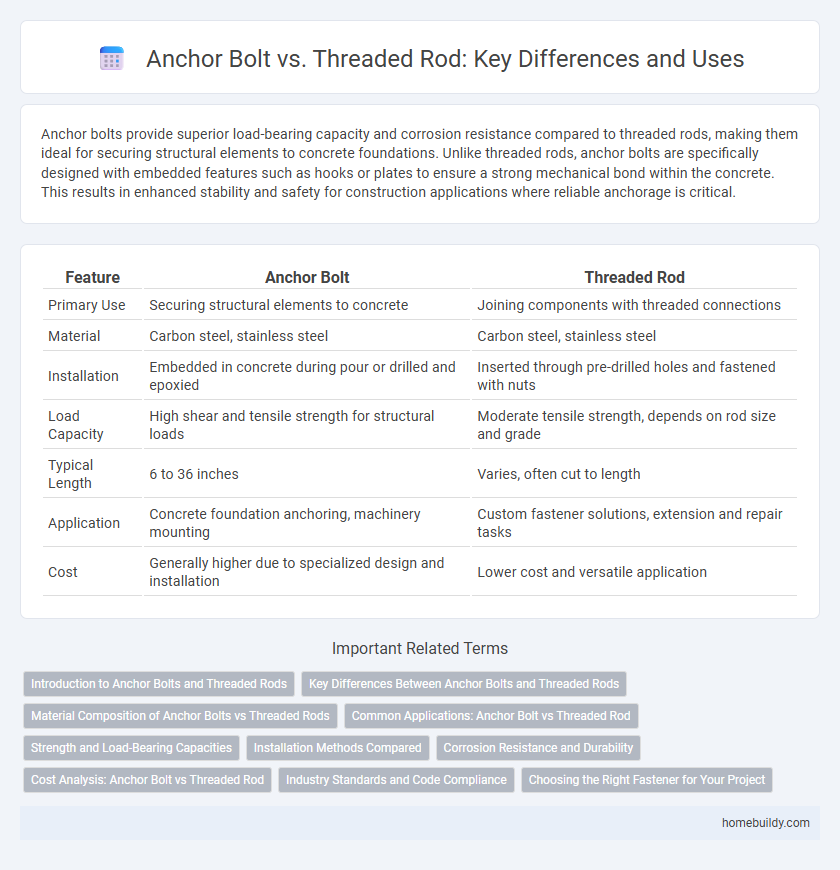Anchor bolts provide superior load-bearing capacity and corrosion resistance compared to threaded rods, making them ideal for securing structural elements to concrete foundations. Unlike threaded rods, anchor bolts are specifically designed with embedded features such as hooks or plates to ensure a strong mechanical bond within the concrete. This results in enhanced stability and safety for construction applications where reliable anchorage is critical.
Table of Comparison
| Feature | Anchor Bolt | Threaded Rod |
|---|---|---|
| Primary Use | Securing structural elements to concrete | Joining components with threaded connections |
| Material | Carbon steel, stainless steel | Carbon steel, stainless steel |
| Installation | Embedded in concrete during pour or drilled and epoxied | Inserted through pre-drilled holes and fastened with nuts |
| Load Capacity | High shear and tensile strength for structural loads | Moderate tensile strength, depends on rod size and grade |
| Typical Length | 6 to 36 inches | Varies, often cut to length |
| Application | Concrete foundation anchoring, machinery mounting | Custom fastener solutions, extension and repair tasks |
| Cost | Generally higher due to specialized design and installation | Lower cost and versatile application |
Introduction to Anchor Bolts and Threaded Rods
Anchor bolts are specialized fasteners designed to secure structures to concrete, offering high tensile strength and corrosion resistance. Threaded rods, also known as all-thread rods, provide versatile fastening solutions but lack the embedded anchoring feature of anchor bolts. While both are made from steel alloys, anchor bolts are molded or cast into concrete foundations, ensuring durability and stability in construction projects.
Key Differences Between Anchor Bolts and Threaded Rods
Anchor bolts are engineered for securing structural elements to concrete, featuring a bent or hooked end for strong embedment, while threaded rods are straight, fully threaded fasteners often used for tension applications and adjustable connections. Anchor bolts provide enhanced load-bearing capacity and resistance to shear forces due to their embedded design, unlike threaded rods which rely on nuts and washers for fastening. Material composition and installation methods also differ, with anchor bolts typically cast into concrete during curing, whereas threaded rods are inserted post-construction or used in conjunction with anchor sleeves.
Material Composition of Anchor Bolts vs Threaded Rods
Anchor bolts are typically made from high-strength carbon steel or stainless steel, offering enhanced corrosion resistance and durability, whereas threaded rods may use a wider range of materials including lower-grade steels. The material composition of anchor bolts often undergoes heat treatment to increase tensile strength, essential for structural applications. In contrast, threaded rods are usually manufactured with less stringent material specifications, making them more versatile but less specialized for heavy-load anchoring.
Common Applications: Anchor Bolt vs Threaded Rod
Anchor bolts are commonly used in construction to secure structural elements to concrete, such as columns, light poles, and machinery bases, providing superior load-bearing capacity and corrosion resistance. Threaded rods find frequent application in situations requiring adjustable length or fastening through multiple components, like suspension systems, pipe hangers, and temporary supports. The choice between anchor bolts and threaded rods depends on the specific structural demands, with anchor bolts preferred for permanent fixture stability and threaded rods for versatile, customizable connections.
Strength and Load-Bearing Capacities
Anchor bolts exhibit superior strength and load-bearing capacities compared to threaded rods due to their embedded design, which secures structural elements firmly in concrete. The mechanical interlock provided by the expansion or cast-in-place installation enhances resistance to shear and tension forces, making anchor bolts ideal for heavy-duty construction applications. Threaded rods, while versatile, lack the same level of embedded support, typically resulting in lower load thresholds and reduced structural stability.
Installation Methods Compared
Anchor bolt installation requires embedding the bolt into concrete or masonry during the pouring process, ensuring a secure and permanent hold, while threaded rod installation involves drilling and using epoxy or mechanical anchors to fasten it to existing structures. The anchor bolt method provides higher load capacity and stability due to its integration within the substrate, whereas threaded rods offer flexibility and ease of retrofit applications. Proper selection depends on the structural requirements and the phase of construction, with anchor bolts favored for new builds and threaded rods preferred for modifications or repairs.
Corrosion Resistance and Durability
Anchor bolts typically offer superior corrosion resistance compared to threaded rods due to their specialized coatings and materials such as galvanized steel or stainless steel. These enhanced corrosion-resistant properties significantly improve the durability and lifespan of anchor bolts in harsh environments, reducing maintenance and replacement costs. Threaded rods, while versatile, often require additional protective treatments to achieve comparable corrosion resistance and durability in structural applications.
Cost Analysis: Anchor Bolt vs Threaded Rod
Anchor bolts typically offer a lower installation cost compared to threaded rods due to reduced labor and fewer components required for secure anchorage. Threaded rods may incur higher expenses because of additional nuts, washers, and potential need for custom cutting or threading on-site. Evaluating total project costs, including material price, installation time, and durability, often favors anchor bolts for budget-sensitive construction applications.
Industry Standards and Code Compliance
Anchor bolts adhere to specific industry standards such as ASTM F1554 and ACI 318, ensuring reliable performance in construction applications. Threaded rods, while versatile, may not always meet the stringent code compliance requirements necessary for structural anchoring without additional certification. Choosing anchor bolts guarantees conformity with building codes and safety regulations critical for load-bearing connections.
Choosing the Right Fastener for Your Project
Anchor bolts offer superior load-bearing capacity and corrosion resistance compared to threaded rods, making them ideal for structural applications requiring secure and permanent fastening. Threaded rods provide versatility and ease of installation, especially in non-structural projects or when adjustable length is necessary. Selecting the right fastener depends on project requirements such as load demands, environmental conditions, and installation complexity to ensure optimal performance and safety.
anchor bolt vs threaded rod Infographic

 homebuildy.com
homebuildy.com